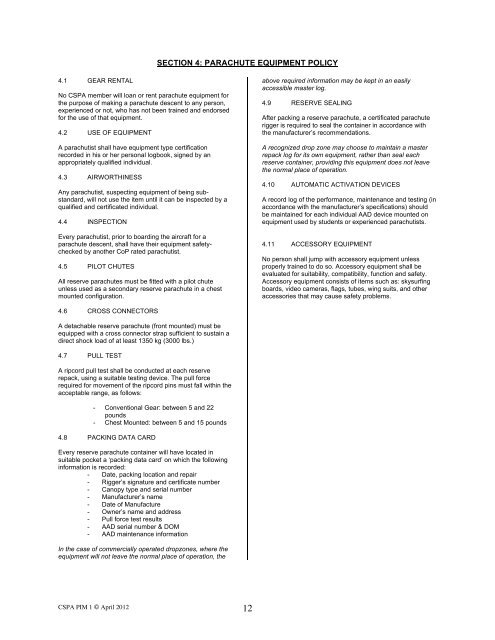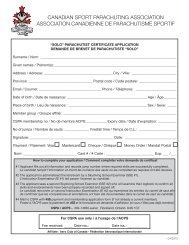PIM 1 2012 Final - Canadian Sport Parachuting Association
PIM 1 2012 Final - Canadian Sport Parachuting Association
PIM 1 2012 Final - Canadian Sport Parachuting Association
You also want an ePaper? Increase the reach of your titles
YUMPU automatically turns print PDFs into web optimized ePapers that Google loves.
4.1 GEAR RENTAL<br />
No CSPA member will loan or rent parachute equipment for<br />
the purpose of making a parachute descent to any person,<br />
experienced or not, who has not been trained and endorsed<br />
for the use of that equipment.<br />
4.2 USE OF EQUIPMENT<br />
A parachutist shall have equipment type certification<br />
recorded in his or her personal logbook, signed by an<br />
appropriately qualified individual.<br />
4.3 AIRWORTHINESS<br />
Any parachutist, suspecting equipment of being substandard,<br />
will not use the item until it can be inspected by a<br />
qualified and certificated individual.<br />
4.4 INSPECTION<br />
Every parachutist, prior to boarding the aircraft for a<br />
parachute descent, shall have their equipment safetychecked<br />
by another CoP rated parachutist.<br />
4.5 PILOT CHUTES<br />
All reserve parachutes must be fitted with a pilot chute<br />
unless used as a secondary reserve parachute in a chest<br />
mounted configuration.<br />
4.6 CROSS CONNECTORS<br />
A detachable reserve parachute (front mounted) must be<br />
equipped with a cross connector strap sufficient to sustain a<br />
direct shock load of at least 1350 kg (3000 lbs.)<br />
4.7 PULL TEST<br />
A ripcord pull test shall be conducted at each reserve<br />
repack, using a suitable testing device. The pull force<br />
required for movement of the ripcord pins must fall within the<br />
acceptable range, as follows:<br />
SECTION 4: PARACHUTE EQUIPMENT POLICY<br />
- Conventional Gear: between 5 and 22<br />
pounds<br />
- Chest Mounted: between 5 and 15 pounds<br />
4.8 PACKING DATA CARD<br />
Every reserve parachute container will have located in<br />
suitable pocket a ‘packing data card’ on which the following<br />
information is recorded:<br />
- Date, packing location and repair<br />
- Rigger’s signature and certificate number<br />
- Canopy type and serial number<br />
- Manufacturer’s name<br />
- Date of Manufacture<br />
- Owner’s name and address<br />
- Pull force test results<br />
- AAD serial number & DOM<br />
- AAD maintenance information<br />
In the case of commercially operated dropzones, where the<br />
equipment will not leave the normal place of operation, the<br />
CSPA <strong>PIM</strong> 1 © April <strong>2012</strong> 12<br />
above required information may be kept in an easily<br />
accessible master log.<br />
4.9 RESERVE SEALING<br />
After packing a reserve parachute, a certificated parachute<br />
rigger is required to seal the container in accordance with<br />
the manufacturer’s recommendations.<br />
A recognized drop zone may choose to maintain a master<br />
repack log for its own equipment, rather than seal each<br />
reserve container, providing this equipment does not leave<br />
the normal place of operation.<br />
4.10 AUTOMATIC ACTIVATION DEVICES<br />
A record log of the performance, maintenance and testing (in<br />
accordance with the manufacturer’s specifications) should<br />
be maintained for each individual AAD device mounted on<br />
equipment used by students or experienced parachutists.<br />
4.11 ACCESSORY EQUIPMENT<br />
No person shall jump with accessory equipment unless<br />
properly trained to do so. Accessory equipment shall be<br />
evaluated for suitability, compatibility, function and safety.<br />
Accessory equipment consists of items such as: skysurfing<br />
boards, video cameras, flags, tubes, wing suits, and other<br />
accessories that may cause safety problems.




